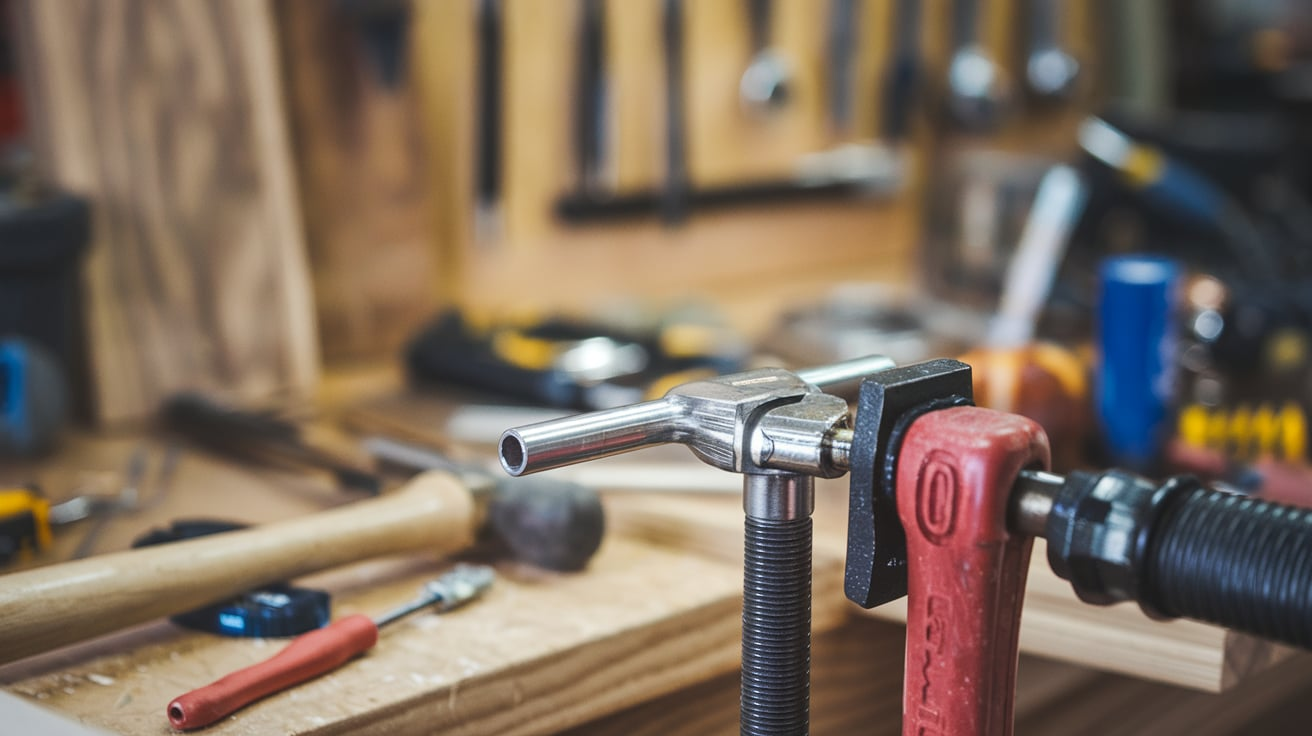If you’re looking for a tool that can hold objects firmly while you work, then a clamp tool is exactly what you need. A clamp tool is used in many different fields, from woodworking to automotive repairs, to keep materials secure. Whether you’re fixing a leaking pipe or holding together two pieces of wood, clamp tools make the job easier and safer.
Clamp tools come in many different types, each designed for a specific purpose. Some clamp tools are small and simple, while others are large and complex. For example, bar clamps are great for woodworking, while C-clamps are perfect for metalworking. The main purpose of these tools is to provide a strong grip, ensuring that your materials stay in place while you cut, glue, or repair. With so many options available, it’s important to understand which clamp tool works best for your specific needs to make your project go smoothly.
What Is a Clamp Tool and How Does It Work?
A clamp tool is a device used to hold or secure objects together while you work. These tools provide a tight grip, preventing movement and ensuring stability for various tasks such as woodworking, metalworking, and even automotive repairs. They come in different shapes and sizes, designed to fit the specific needs of your project. By applying inward pressure, a clamp tool holds materials in place, allowing you to cut, drill, glue, or weld without the worry of objects shifting. Clamp tools are widely used because they are easy to use and incredibly reliable, making them essential for professionals and DIY enthusiasts alike.
Different Types of Clamp Tools for Every Job
There are several types of clamp tools, each suited for different tasks and materials. For instance, bar clamps are ideal for woodworking as they apply even pressure across wide surfaces. C-clamps, on the other hand, are often used for metalworking due to their ability to hold objects tightly in place. F-clamps are another popular choice in woodworking, providing a strong grip on smaller pieces. Quick clamps are perfect for jobs that require speed, as they are easy to adjust with just one hand. Depending on the specific requirements of your task, it’s important to choose the right type of clamp tool for optimal results.
How to Choose the Best Clamp Tool for Your Project
Choosing the best clamp tool for your project depends on several factors, including the material you’re working with, the size of the project, and the amount of pressure required. First, consider the type of material you are clamping—wood, metal, or plastic—as different clamp tools are designed for specific materials. Additionally, think about the size of the project; large projects may require more robust tools like bar clamps, while smaller tasks can be handled with quick clamps or spring clamps. Lastly, make sure the clamp tool you choose can apply the necessary amount of pressure without damaging the materials you’re working with, ensuring a secure hold.
Why a Clamp Tool is Essential in Woodworking and DIY Projects
A clamp tool is essential in woodworking and DIY projects because it allows you to securely hold pieces together while gluing, nailing, or screwing. Whether you’re assembling furniture, repairing cabinets, or working on intricate wood designs, a clamp tool is crucial for providing stability and precision. It ensures that the parts stay in place, preventing shifts or misalignments during the work process. Without the use of clamp tools, it would be nearly impossible to achieve clean, accurate results, especially for complex projects. Additionally, they help to prevent damage to the material by evenly distributing pressure without causing cracks or splits.
The Importance of Using the Right Clamp Tool in Automotive Repairs
In automotive repairs, using the right clamp tool is critical for ensuring safety and precision. Whether you’re working on car engines, exhaust systems, or body repairs, clamps help secure parts in place, allowing you to work efficiently without worrying about the parts shifting. Automotive work often involves tight spaces and heavy-duty components, making it essential to choose clamps that offer strong, consistent pressure. For instance, hose clamps are commonly used to secure hoses, while C-clamps help hold metal parts during welding or grinding. Using the appropriate clamp tool ensures that repairs are done correctly and safely, preventing accidents and ensuring the vehicle functions properly.
Step-by-Step Guide to Using Clamp Tools Safely
Using clamp tools safely is important to avoid accidents and ensure the longevity of the tools. Start by inspecting the clamp tool for any damage or wear. Always choose the correct clamp for your project to ensure a secure hold. When clamping, position the tool carefully to avoid damaging the workpiece. Tighten the clamp slowly, making sure not to over-tighten it, which could cause the material to crack or break. Keep your hands clear of the clamped area to prevent injury. Once the work is done, remove the clamp gently and store it in a safe, dry place to prevent rusting or other damage.
How to Maintain and Care for Your Clamp Tools
To extend the life of your clamp tools, regular maintenance is essential. After each use, clean the clamp tool to remove dirt, sawdust, or metal shavings that may have accumulated. For metal clamps, lightly oil the moving parts to prevent rust and ensure smooth operation. Make sure the clamping surfaces are free from debris and check for any signs of wear or damage. If a clamp tool is damaged or broken, replace the parts promptly to avoid accidents during future use. Proper storage is also important—keep your clamps in a dry, organized space to prevent them from becoming bent, rusted, or otherwise damaged.
Top Brands of Clamp Tools You Can Trust
When it comes to clamp tools, choosing a reliable brand is crucial for quality and durability. Some top brands include Irwin, Bessey, and Kreg, which are known for producing high-quality clamp tools that last for years. Irwin offers a wide range of clamps, from bar clamps to C-clamps, providing professional-grade tools for any project. Bessey specializes in precise and heavy-duty clamps, while Kreg is popular for woodworking projects, especially when it comes to jigs and fixtures. These trusted brands ensure that you’re getting a tool that is both effective and long-lasting, making them a great investment for your workshop.
Common Mistakes People Make When Using Clamp Tools
One of the most common mistakes people make when using clamp tools is over-tightening the clamp. Over-tightening can cause damage to the material you’re working with, leading to cracks or breakage. Another mistake is using the wrong type of clamp for the task. For instance, using a small C-clamp on a large woodworking project may not provide enough grip, resulting in an unstable workpiece. It’s also important not to place the clamp in the wrong spot, as this can cause uneven pressure or misalignment. Lastly, neglecting to clean and maintain your clamps can lead to rust, difficulty in use, or tool failure when you need it most.
How Clamp Tools Make Your Work More Efficient and Precise
Clamp tools make your work more efficient and precise by providing a stable and secure hold on your materials. This allows you to focus on your task without worrying about the parts moving out of place. In woodworking, for example, clamps hold joints together while glue dries, ensuring that the pieces align correctly for a strong bond. In metalworking, clamps keep pieces in place while you weld or drill, preventing mistakes. By reducing the chances of errors and making tasks easier to perform, clamp tools ultimately save you time and effort, allowing you to complete projects faster and with greater precision.
Conclusion
In conclusion, a clamp tool is an essential device that can make your projects easier and more efficient. Whether you’re working on wood, metal, or automotive repairs, choosing the right clamp tool ensures a stable hold on your materials, making your work safer and more precise. These tools come in various types, each designed for specific jobs, so picking the right one is key to success.
Remember, maintaining and using your clamp tools correctly is just as important. A well-maintained clamp can last for years and save you time on future projects. So, always clean your tools after use, store them properly, and choose the right clamp for each task to get the best results!
FAQs
Q: What is the best clamp tool for woodworking?
A: The best clamp tool for woodworking is typically a bar clamp or F-clamp, as they offer strong and even pressure for wood pieces.
Q: How do I use a clamp tool safely?
A: Always check for damage before using the clamp, tighten it slowly, and avoid over-tightening to prevent injury or damage to materials.
Q: Can I use a clamp tool on metal?
A: Yes, C-clamps and bar clamps are great for holding metal parts during welding or metalworking tasks.
Q: How do I maintain my clamp tools?
A: Clean your clamps after use, lubricate the moving parts with oil, and store them in a dry place to prevent rust.
Q: Are quick clamps easy to use?
A: Yes, quick clamps are very easy to use, as they can be adjusted with one hand and are perfect for fast, light jobs.

